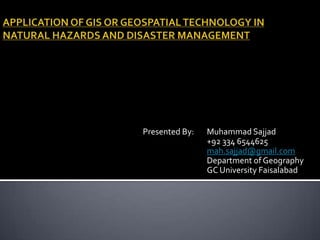
Application of gis in natural disaster management
- 1. Presented By: Muhammad Sajjad +92 334 6544625 mah.sajjad@gmail.com Department of Geography GC University Faisalabad
- 2. Disaster Management A systematic process which aims to reduce the impact or consequences of any adverse event like, Flood, Earthquake, Disease etc. It is more then just response and relief. Hazard It is a potential for a natural or Human-Caused event with negative impacts or consequences. Emergency It is a situation generated by real or imminent occurrence od an event that requires immediate response/Attention. Disaster It is a natural or human-caused event which causes intensive negative impact on people, goods, services and/or environment acceding the affected community’s capability to respond.
- 3. Risk Risk is the potential or likelihood of an emergency to occur. For example, the risk of damage to a structure from an earthquake is high if it is built on or adjacent to an active earthquake fault. Risk can be determined as product of Hazard H and Vulnerability V, R=H x V Vulnerability Vulnerability is the extent to which a community’s structure, services or environment is likely to be damaged or disrupted by the impact of a hazard, the vulnerability could be i) Tangible/ Material ii) Intangible/ Abstract
- 4. An Emergency is a situation in which the community is capable of coping. It is a situation generated by the real or imminent occurrence of an event that requires immediate attention and that requires immediate attention of emergency resources. A Disaster is a situation in which the community is incapable of coping. It is a natural or human-caused event which causes intense negative impacts on people, goods, services and/or the environment, exceeding the affected community’s capability to respond; therefore the community seeks the assistance of government and international agencies.
- 5. Better data storage Better data analysis Handy in planning Helpful for stakeholders/ Decision Makers
- 7. GIS is a tool that allows users to create interactive queries (user created searches), analyze the spatial information, edit data, maps, and present the results of all these operations. GIS provides environment for effective and efficient storage and manipulation of remotely sensed or other spatial and non-spatial data types for both scientific management and policy oriented information. The specific application in Risk Assessment are, Hazard mapping to show earthquake, floods, landslide or fire. These maps are used for warning system.
- 8. GIS application can be useful in the following activities To create Hazard inventory maps LocateCritical Facilities Create and manage associate related database VulnerabilityAssessment
- 9. Planning GIS is useful in helping with forward planning. It provides the framework for planners and disaster managers to view spatial data by way of computer based maps. Mitigation Representation of High risk areas Facilitates the implementation of necessary mechanism to lessen the impact. Preparedness Identification of emergency areas Positions of related departments, Agencies, and Human Resources Make it easier for security and shelters provides to plan the strategies Answer that who is to be based where and at what phase of emergency
- 10. Response Provide accurate information on exact location of an emergency situation Time saving during the determination of trouble areas (Quick Response) Used as floor guide for evacuation routes Recovery Mapping level of damage Information related to disrupted infrastructure, number of persons died or injured and impact on Environment.
- 11. GIS can be used by shelter operators to capture specific personal details of persons being housed at the shelters. It would make it possible to assess the number of needed shelters and the structure of that suffering population like, children, adults, disables etc..
- 12. In affected areas during and after disaster, Food Drops is always likely to take place. This process can be helped with GIS as maps can be generated which identify the specific areas with clusters of victims are located and the unique need of persons within these clusters.
- 13. The data is gathered for the analysis and to assess the need of activities and actions before, during and after the disaster. By the use of this data, maps of most vulnerable areas can be produced and those areas can be highlighted which are most prone to disasters.
- 14. Ability to represent geographical information 2D and 3D It provides the facility to integrate the different geo-spatial information. It effectively collect, analyze, manage and distribute up-to-date information It is versatile and easy to use for big purposes, but requires a little training to get individuals involved in process. The GIS based database provides better environment for future planning.
- 15. Vayas, T. & Desai, A., 2007. Information Technology for Disaster Management. Computing for Nation Development. New Delhi. Jhonson, R., 2000. GIS Technology for Disaster and Emergency Management. ESRI white papers. United States VUSSC* . “Introduction to Disaster Management”. Ver. 1 *VUSSC= Virtual University for small States of the Commonwealth
